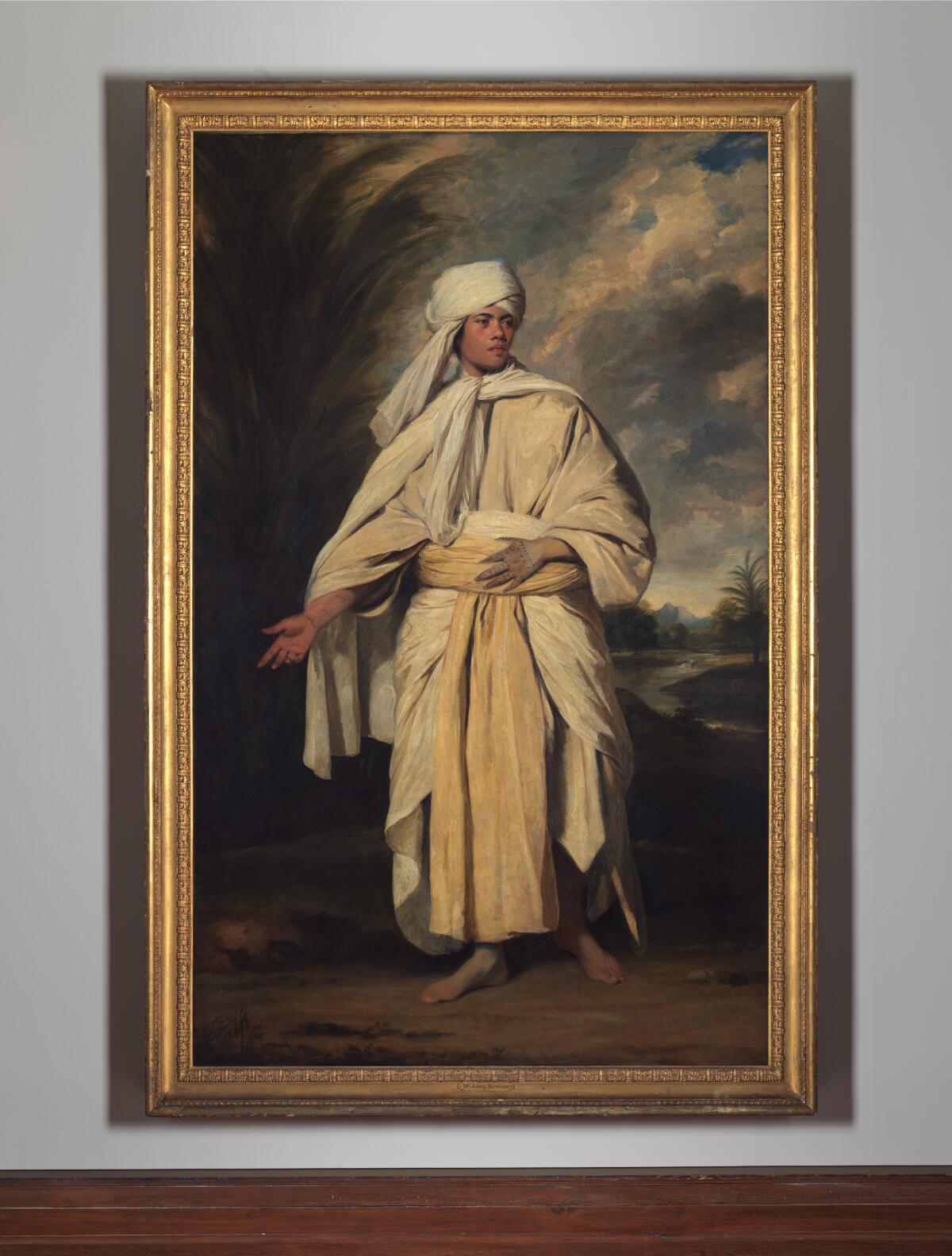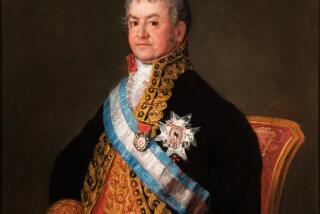Commentary: The real reason the Getty and National Portrait Gallery’s joint acquisition is a big deal

- Share via
News flashed around the British press and social media early Friday morning of an unusually clever fundraising gambit: the joint acquisition by London’s National Portrait Gallery and Los Angeles’ J. Paul Getty Museum of a brilliant 18th century portrait by Sir Joshua Reynolds (1723-1792).
“Mai is staying! Joshua Reynolds’ Portrait of Omai will be acquired and owned jointly by @NPGLondon and @GettyMuseum — just announced,” tweeted author Lucy Ward, who has been instrumental in efforts to keep the privately owned painting from leaving the U.K. Its owner, Dublin-based businessman John Magnier, offered the work for sale on the open market for a reported £50 million (more than $61 million) almost two years ago, and an export license was immediately deferred to give a U.K. buyer a chance to match the asking price.
“Celebrating that the great Reynolds portrait Omai — Mai as he was actually named — is to stay!” a prominent British historian tweeted, correcting the Polynesian sitter’s name. (The “o” before “mai” is an introductory word, like “here’s” or “I am.”) Another writer exulted, “Excellent news. Following a brilliant campaign” to save the masterpiece for the British public.
“The idea,” explained London’s Art Newspaper, “is that the Reynolds painting will be on display in London and Los Angeles half the time, being moved between the two museums perhaps every five years.”
“National Portrait Gallery and Getty to share ownership of Reynolds portrait” headlined the news from the U.K.’s Museums Assn.
And on went the rejoicing — understandably so, given what appears to be a magnificent work of art. Nearly 8 feet tall, the oil painting depicts a tattooed young Tahitian man in his early 20s who sailed to London with Captain Cook in 1774. Mai became a sensation in aristocratic British society, feted by King George III.
Reynolds took the celebrity route for his portrait of Mai. He is theatrically dressed in classical Roman robes and a turban, and he’s posed before a wholly imagined and idealized South Pacific landscape.
Many scholars hail the work as Reynolds’ greatest painting. Whether that’s the case is hard to say, as the picture has been in private hands and rarely shown in public since it was painted almost 250 years ago. (Reynolds was putting brush to canvas just around the time a quill was being put to parchment in Philadelphia to write the Declaration of Independence.) I’ve never seen it, nor have many other critics and historians.
Simon Schama, the great British historian of European cultural history, had not laid eyes on it either, until a few weeks ago, when London’s National Portrait Gallery gave him a look. Schama promptly posted a stirring plea to YouTube to keep the picture in Britain and available to the public.
An acquisition by the NPG, reopening June 22 after a major three-year renovation, would in many ways represent a full-scale coming-out party for a magnificent Grand Manner portrait of a person of color — a rarity in an aristocratic genre so well represented at, for example, the Huntington Library, Art Museum, and Botanical Gardens in San Marino. (Reynolds’ “Sarah (Kemble) Siddons as the Tragic Muse,” “Portrait of Samuel Johnson, ‘Blinking Sam’” and “Diana (Sackville), Viscountess Crosbie” are standouts among a dozen paintings by the artist there.) A portrait of the Black writer and composer Ignatius Sancho by Thomas Gainsborough, Reynolds’ great rival, painted six years before “Mai,” is in the collection of the National Gallery of Canada.
Drowned out in all the hoopla, however, were some rather sobering caveats. The formal press release jointly issued by the NPG and the Getty was careful to note some “ifs.”
NPG director Nicholas Cullinan was excited to “hopefully become co-owners” of the masterpiece with the Getty.
Getty Trust CEO Katherine E. Fleming is happy for the “opportunity to participate” in what would be an innovative arrangement.
British Arts and Heritage Minister Lord Parkinson of Whitley Bay expressed delight that the two museums “are closing in on finalizing a deal.”
Getty Museum director Timothy Potts was most direct, noting that the sharing plan would happen only “if the National Portrait Gallery is successful in the final phase of its fundraising campaign.”
Will it be?
Plainly, that’s what today’s announcement is designed to push for. It’s a last-ditch fundraising pitch.
For a spectacular art museum acquisition to be formally declared before it has actually taken place is highly unusual. This ballyhooed announcement seems designed to create such a celebratory mood around a painting little-known to the British public that failing to capture it now would be nothing less than a national scandal.
It’s Britain, after all, not the Getty that hasn’t been able to muster the necessary funds. U.K. fundraising stalled at under $30 million — less than half the asking price. The Getty, secure with an $8-billion endowment, offered to share the purchase some months ago, but Britain at first declined, determined to have the picture remain in London full-time. Less than two weeks ago the deferment on the export license, which had been extended once, was set to expire after a full year. For an apparently unprecedented third time it was extended again, pushed to June 10 — just days before the NPG’s planned reopening.
News about the prospective joint purchase represents a significant turnaround in the NPG’s thinking. A yawning gap of more than $30 million in the fundraising goal has been slashed to a considerably more manageable figure of about $1.2 million. Partial ownership is now preferable to no ownership at all, especially for a painting that instantly becomes the most important in the entire museum collection.
Of course, without the export license deferral, the Getty might have been the museum to hold the masterpiece full-time, negotiating acquisition at the steep asking price. It would have been illuminating, especially under the big-money circumstances, to see it hanging in Brentwood with the three-quarter-length Gainsborough “Portrait of James Christie,” founder of the London auction house that still bears his name.
Britain’s protectionist art-export laws have been a problem for years, and the apparently unprecedented extensions to snag the Reynolds show how tattered the system has become. Now that the art market resides in the stratosphere, while cash-strapped Britain struggles, it will only worsen. Once Reynolds’ “Mai” has been secured, that’s a problem that officials desperately need to address.
More to Read
The biggest entertainment stories
Get our big stories about Hollywood, film, television, music, arts, culture and more right in your inbox as soon as they publish.
You may occasionally receive promotional content from the Los Angeles Times.











